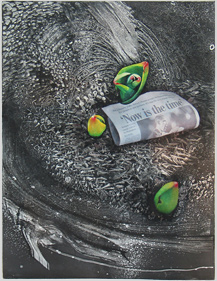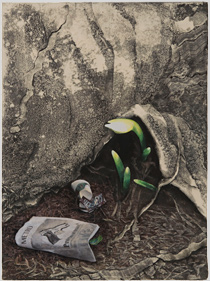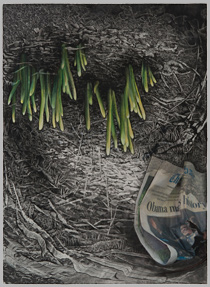| |
|
|
 |


EXEMPLARY PRACTICE:
The Art of Yumiko Irei-Gokce
E S S A Y
by Prof. Dana Saulnier
 |
"Uprising: A New Era"
25" x 18" |
 |
"Protecting: Help or Harm"
25" x 18" |
|
Yumiko Irei-Gokce conceives the spaces of her work as
zones of movement and transition. She speaks of dualisms:
micro- macro, growth– decay, and eternal– temporary. To
conceive these works as representations of nature is to miss
their status as evolving structures, the acts of a mind locating
itself in movement. Irei-Gokce identifies her attitude with
eastern philosophy and the mind of Zen. This makes a great
deal of sense. To grasp the potency of her work we must
understand it as a thing born of process. For the maker,
small inflections of concept orient difference. Thinking
generates form. Making generates difference.
A consistent dialogue with paper informs her extensive array
of procedures. Gampi paper, very thin but strong, along
with Lokuta paper from Nepal are often elements in works
constructed from multiple layers that act as an analogue to
flesh. In Once IWas a Beautiful Tree, the fluid, wrinkled,
sheets set in motion a series of alternative responses,
producing the dissonance and differences so vital in her art.
Yumiko Irei-Gokce has consistently explored ‘all over’
composition. Her frontal luminous fields hold marks and
texture in restless continuity. The individuality of specific
marks is measured with the marshaled energy of repetitive
marks as well as those marks dependence upon the
luminous spatial envelope of the whole. These fields produce
a fragile continuity, a situation ready for movement. Yumiko
is frequently taking things apart and putting them together.
In this sense, her Collagraph print is a touchstone. The artist
prepares the textured, incised and pasted plate used to
produce the Collagraph print.
We see her extending her sensibility with mixed media when she
makes her assemblages on canvas, as in The Moment; His Departure
to the Star, where the artist enlarges her vocabulary to carefully
depicted hands in a work that successfully communicates a personal
loss. Her technical range leverages her abstractions, allowing a
responsive, vital, sophisticated, de-stabilizing play of interpretive
meanings. Her art is a space where time moves; a space of
becoming. This is where she works. This is where she thinks.
Yumiko Irei-Gokce’s singular monotypes seem to me to
be a core practice in recent years. Here she most readily
produces effective tensions. Yumiko frequently tests her
ability by bringing an expanded vocabulary into play.We
can see this in works that incorporate digital images,
such as Uprising; A New Era, referring directly to recent
political events. In another monotype, Under a Spell,
Perseverance Prevails Against All Odds the most readily
identifiable forms are vegetative, presented in a range of
color that pulses towards saturation while standing in
contrast to the luminous field.We are immediately
conscious of the layered relational ordering principle
when we confront her colored forms in this
monochrome space.We must traverse this distance. In
fact, everything in this work calls attention to variable
perception, where the artist draws out our attention to
time. The vegetative forms are specifically described, yet
they are shown to us as ‘sprouts’, as ‘just about’ to
become the relatively stable exemplars of our
expectations: flower, stem, or stalk. They are potential.
They are ‘not yet’. Their ‘being in flux’ is as important as
any identification, any name we might give them.
Fleeing, fleeting, but omnipresent time, unfolds for us as
the artist gives us shifting movements of before, after,
and not yet. Recognition and expectation, nearness and
distance, play out in her highly specific choices of color,
texture and tone.
 |
"Ascending: Against All Odds"
25" x 18" |
The earth we think when we see her luminous tonal
field of marks fluctuates between a winter earth that
withholds with a fecund earth that gives. The
withholding and giving of this earth is both the
conceptual and visual ground of the artist’s thinking. In
my view, this ground is her most compelling
achievement: a space withholding/ giving. At times
burnt, inert, and resistant, then shifting, and rhythmically
pulsing with energy, it engenders our expectations and
projects a cycle of perception.We move through it to
growth and decay just as the flow of our thinking, our
transitory ideas and identifications do the same.
This achievement results from Yumiko Irei-Gokce’s
intimacy with her material practice. To grasp what I am
saying here let us metaphorically imagine degrees of such
intimacy as moving from far to near. Nearness realizes
multiple and dense connecting possibilities. Imagine
viewing a riverbed from far above, airborne, seeing its
general course and structure, then moving closer and
closer, until we could navigate the most minute passages
of seeping moisture in the most particular configurations
of material interactions.We would move from the
mainstream to the delta where dense and layered worlds
fold upon one another. From such a close engagement a
density of creative pathways radically expands. This
example metaphorically indicates something of the
masterful artist’s relationship with their medium.
Yumiko Irei-Gokce has attained intimacy with her
material practice: her medium. She is therefore in a
position to provocatively nuance difference.
Her ability to cycle differences is everything. Yumiko
does not give us an authoritative ideal world. She gives
us a rhythm: temporary sense. The openings, gaps, and
elisions occurring where we find only temporary
categories and only provisional identities for what we
are seeing. This structures our perception as movement
more than category agreement. The folded, layered,
flexible durations of her withholding/ giving ground
elaborate her technical operations.We see the artist’s
marks, coalescing and enacting forces. Yet, at the same
time the omnipresent subtle sheen of her luminous tone
slides our thinking to a distant recognition: the vibrating
visual surfaces of video and film. Her restless luminous
field discloses an extended technology of seeing.
We wonder what sort of space is this? Is it natural or
cultural? In recent years this would be a key question.
Yet work such as Yumiko Irei-Gokce’s abstraction
challenges the import of the distinction. Artists such as
TerryWinters and Matthew Ritchie suggest themselves
in this same vein. Doesn’t the limiting question between
nature and culture derail our understanding of her
space? Isn’t the call to classify this space suspect when
this artist can give us both together? Not this or that,
but this and this.
Contemporary abstract art has been energized by the
recognition that it has long functioned as an example of
the virtual. In contemporary culture we live in a world
where internet technology increasingly structures our
time and space. The habits of mind of the artist, the
embrace of accident, change, and evolving structures
take on new relevance in this practical situation.
‘Theory’, so often based in ideological debates
surrounding representation, reveals its limitations in this
rapidly evolving practical situation. Art claims a
particularly relevant position. It too, with decisively
distinct methodologies, is technique rhythmically
structuring mind.
If after contemplating this contemporary situation we
can more thoroughly appreciate the question of
‘practice’, then we can understand that Yumiko Irei-
Gokce is, in a very concrete sense, living in her working
practice. Here we can begin to realize at a deeper level
the dialogue she has been having with us. And, we can
begin to glimpse the quality-- the sense-- of what it has
been for her to traverse this world.
Yumiko Irei-Gokce has lived in the United States for
many years, but she has also lived in Turkey and Japan.
As she has traveled and made a place for herself across
three continents she retains a fragile center in her
Japanese heritage. If, in this essay we are asking what is
at play in her work, what potency arises between
nearness and distance, between growth and decay
between time becoming and lost, then it greatly enriches
our appreciation of Yumiko Irei-Gokce’s work when we
take up her experiences as cultural migrant.What power
and depth this brings to the work.What relevance to
our global age when a masterful artist like Yumiko Irei-
Gokce gives dimension to her world-- a world shared—a
world entwined with her mobility.
Dana Saulnier
Copyright 2009.
Dana Saulnier is a painter who writes about art. He is also a
critic, curator, and Associate Professor of Painting at Miami
University in Oxford, OH |
 |

|
|
|
|